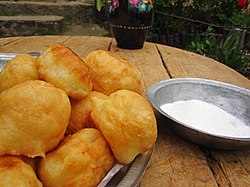Zalabiyeh
 Deep-fried zalabiyeh | |
| Alternative names | Spongy dough (sufgan), zlebia, jalebie, zülbiya, jilapi |
|---|---|
| Type | Fritter, Doughnut |
| Region or state | Middle East, North Africa, West Asia, Ethiopia, Europe |
| Main ingredients | Batter (flour, yeast, water, salt), Optional: eggs, milk, sesame oil, sesame seeds[1] |
Zalabiyeh (
History
The earliest known recipes for zalabiya comes from the 10th century
Different methods have developed in the preparation of the pastry dessert. According to
In 1280, the Jewish–Sicilian doctor Faraj ben Salim translated into Latin a pharmaceutical book, (English: The Table of Countries; Latin: Tacvini Aegritvdinvm et Morborum ferme omnium Corporis humani), which was authored by Ibn Jazla an Arab physician[7] and consists of a number of Persian recipes, including one for "Zelebia".
Among Yemenite Jews, the zalabiyeh was a treat eaten especially during the winter months.[8] In Yemen, the zalabiyeh was fried in a soapstone pot lined with oil about 1 cm. deep, in which oil and sometimes honey was mixed.[9] There, zalabiyeh was "made from a soft yeast bread [and] which is fried on both sides in deep oil. There are those who add to the dough black cumin for improved taste. They are eaten while they are still hot, while some have it as a practice to eat them with honey or with sugar."[10]
Early known origins
According to 2 Samuel 13:8–10
Customs
Zalabiyeh are commonly eaten by Muslims during the month of Ramadan, and during the Diwali celebrations for Hindus and Indian Christian communities during Advent and Easter, and by Sephardic Jews for Hanukkah. In Lebanon they are eaten on the night of January 5 to celebrate the baptism of Jesus Christ. The dough is mixed with aniseed and, in the South of the country, three holes are made in the dough to symbolize the Holy Trinity. They are eaten in both their elongated form and their round form on that day.
Zalabiyeh (or zelebi) are a traditional sufgan ("spongy dough") for Persian Jews.[3]
Modern variations
The fritter is very common in the Indian subcontinent, in countries such as India, Pakistan, Sri Lanka, Nepal, Bangladesh, although made differently to that of the Middle Eastern and North African variety. In many Middle Eastern and North African countries, such as Iran, Iraq, Jordan, Syria, Lebanon, Tunisia, Algeria, Sudan, and also in Egypt, they resemble spongy-cakes fried in oil.[citation needed]
In Iran, where it is known as zolbiya, the sweet was traditionally given to the poor during Ramadan. There are several 13th century recipes of the sweet, the most accepted being mentioned in a cookbook by Muhammad bin Hasan al-Baghdadi.[15]
In
In
They are known as zlebia in Tunisian cuisine, jalebie in the Philippines, zülbiya in Azerbaijan, gwaramari in Nepal and jilapi in India.[17]
See also
References
- OCLC 299777900.
- ISBN 9781780235356.
- ^ a b Goldstein, Darra. The Oxford Companion to Sugar and Sweets. Oxford University Press.
- ISBN 978-9004158-672.
- ^ Goldstein, Darra (2012). The Oxford Companion to Sugar and Sweets. Oxford University Press.
- ^ OCLC 8902838136., ch. Zalabiya Fritters (Sweet Crullers)
- PMID 4946293.
- OCLC 1041776317
- ^ OCLC 863513860.
- OCLC 609321911.
- Levi ben Gershon, ibid, and by Rashi (ibid.) who adds that the fine flour used to make the dough was first scalded in hot water before being fried in oil.
- OCLC 233403923, s.v. Hallah 1:5 (sūfğenīn, al-zalābiye)
- OCLC 13977130 (Available online, at HebrewBooks.org: The Geonic Commentary on Seder Taharot - vol. 1), s.v. Keilim 5:1 (p. 15)
- ^ Cf. Mishnah (Hallah 1:5 (p. 83))
- ISBN 978-0-19-967733-7.
- OCLC 492903129. (reprinted in 1994)
- ISBN 9780226646701.

